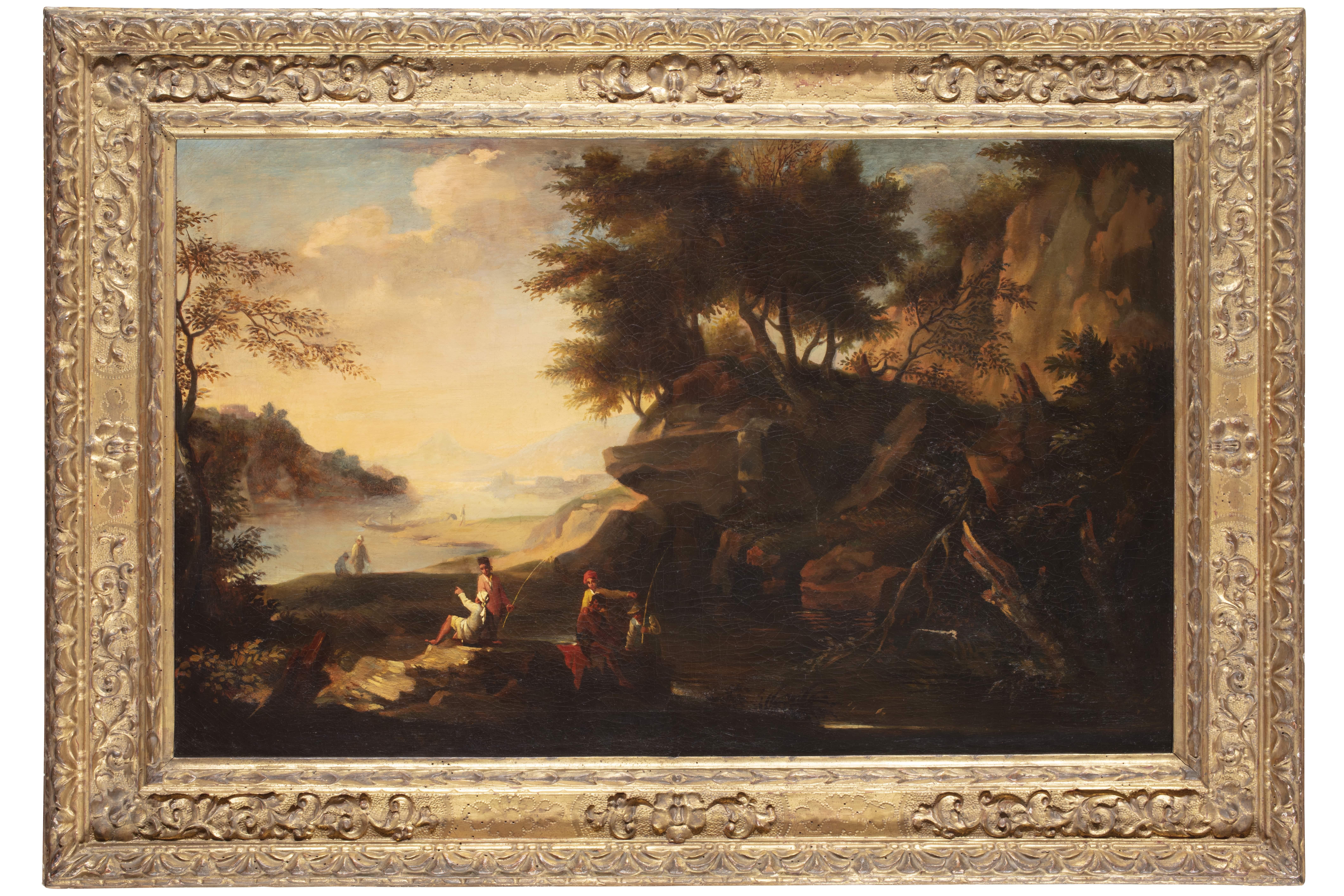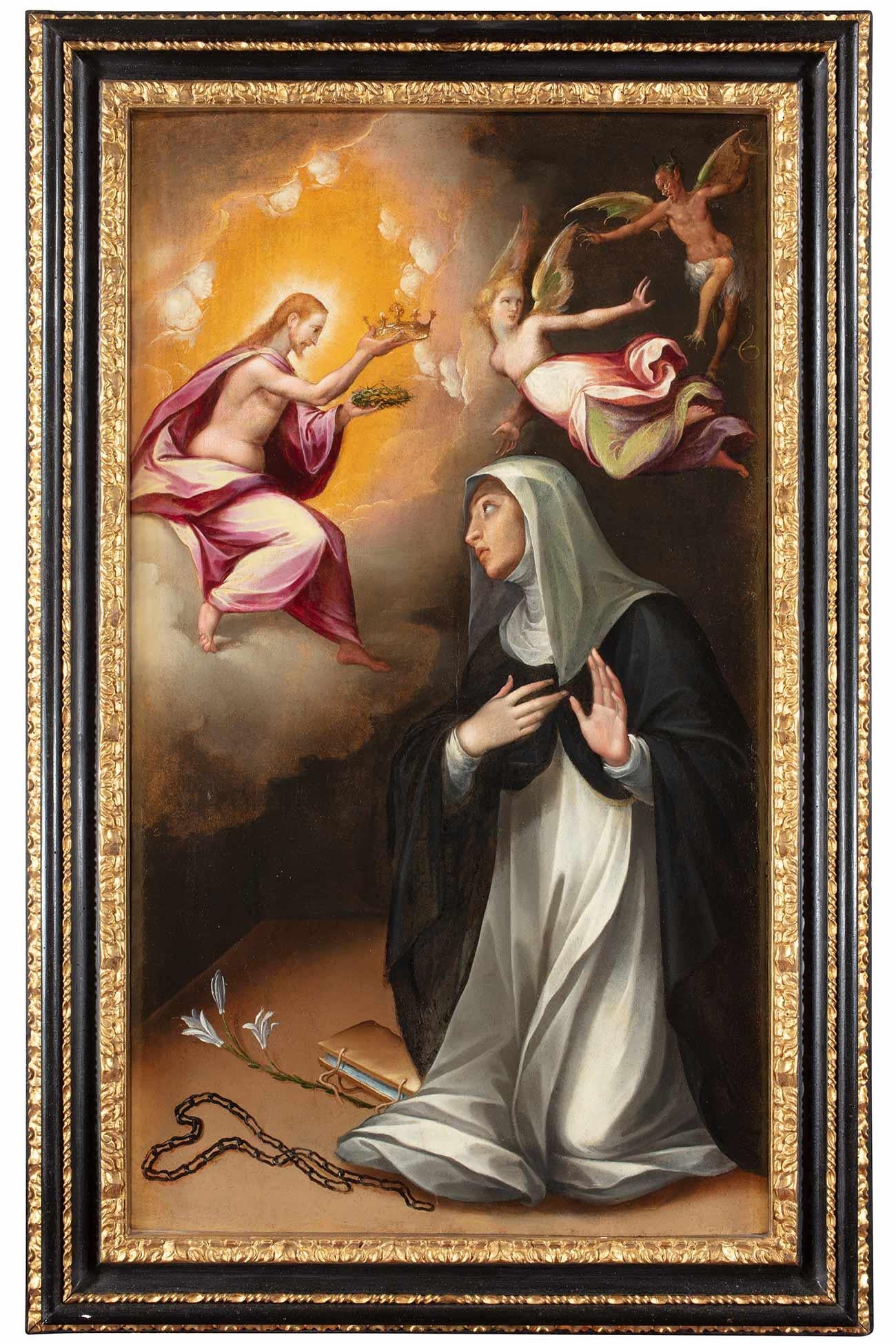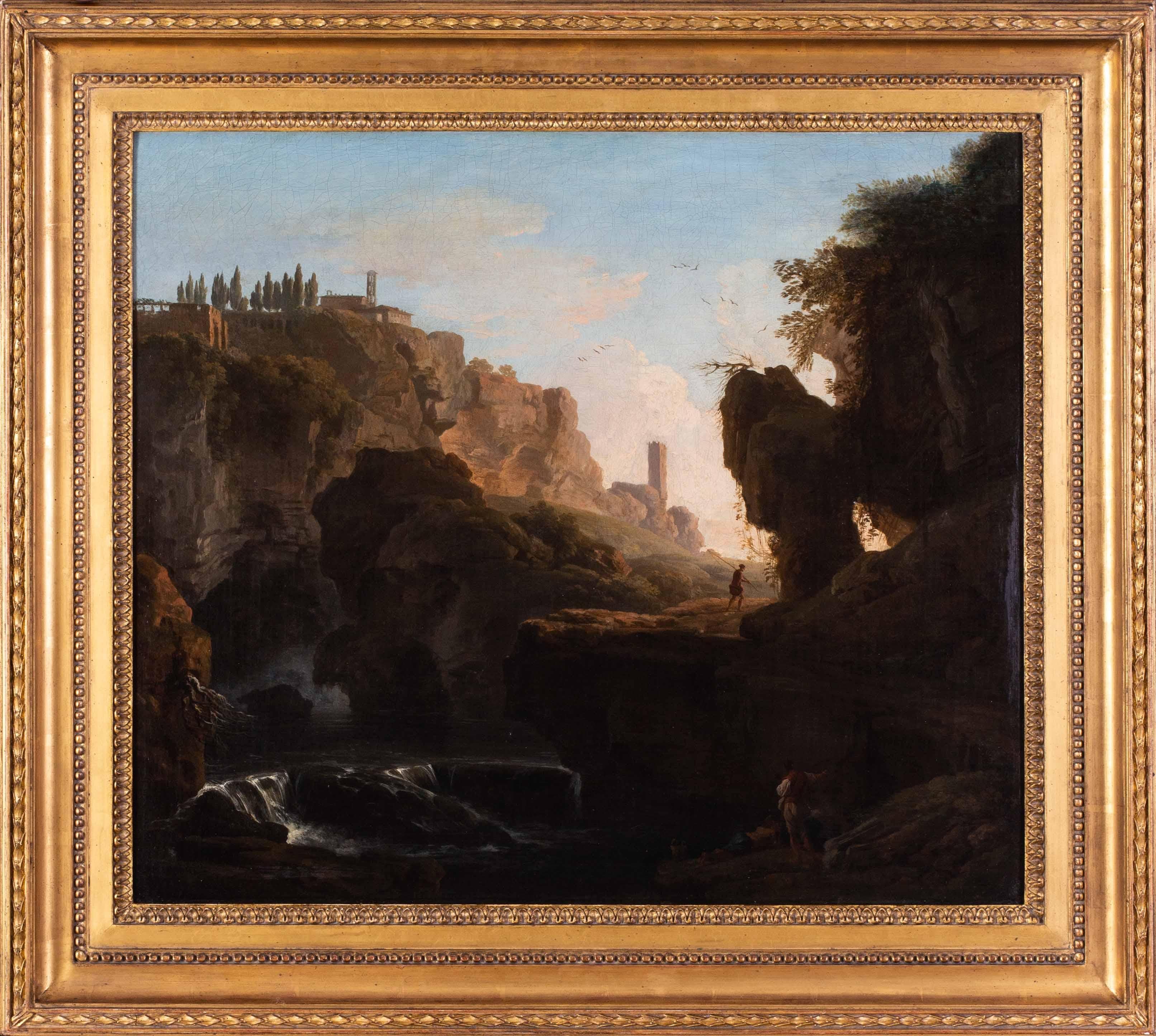Items Similar to A Dune Landscape with Figures Resting and a Couple on Horseback, a View of Nijme
Want more images or videos?
Request additional images or videos from the seller
1 of 12
Salomon van RuysdaelA Dune Landscape with Figures Resting and a Couple on Horseback, a View of Nijmec. 1642-43
c. 1642-43
About the Item
"A Dune Landscape with Figures Resting and a Couple on Horseback, a View of Nijmegen Cathedral Beyond" is a painting by Dutch Old Master painter Salomon van Ruysdael. The painting is unsigned. The framed piece measures 37 1/2 x 54 1/4 x 1 3/4 in.
Born in Naarden where his father, Jacob Jansz de Goyer was a moderately wealthy cabinetmaker, Salomon van Ruysdael initially used the name ‘de Goyer’ but soon followed the example of his eldest brother and adopted ‘Ruysdael’ from the castle of Ruijschdaal in Gooiland, which may once have been a family possession. Shortly after his father’s death, Salomon and his brother, Isaack van Ruysdael (1599-1677), a painter, frame maker, and dealer, moved to Haarlem, where Salomon entered the Guild of St Luke in 1623 and largely painted scenes of the surrounding countryside.
By 1640, Salomon distanced himself from the tonal aesthetic that had largely dominated landscape pictures of the previous decade. Instead, he adopted a more varied and brighter palette that can be seen as part of a wider movement in landscape painting whereupon the impulse to paint the more mundane features of the Dutch environment in a relatively uncomplicated manner was supplanted by a desire to imbue the landscape with a new sense of grandeur and refinement. Salomon did not, for example, intend cloud structures to be simply beautiful features or atmospheric elements that augment the ‘feeling’ of the picture. Instead, he looked to the energy and drama of the sky to suggest familiar poetic or scriptural metaphors vis a vis any number of weather anomalies — natural world reminders of God’s creative power, his benevolence, and his goodness visible from the top of the dunes, from the lands reclaimed from the sea, and from the sea conquered with their mighty ships.
“A Dune with Figures Resting” is a beautifully orchestrated demonstration of that principle carried on the strength of its brilliant staging of light and shadow in creating drama and energy. It is the beau idéal that collectors of seventeenth-century Dutch landscapes value most, illustrated in this case by a dramatic cloud-driven sky that conveys the essential nature of a blustery day, a rising sandy wedge of land that provides a gently sloping diagonal to a lowered horizon on the left gloriously capped by a silvery band of distanced water, and a landscape populated by figures that have come for the bracing air and together, create a kind of euphoric spectacle of life and living; people admiring the scene just as Salomon van Ruysdael wanted us to admire the picture. It is all pitched and brought to dynamic balance by those wind-driven darkened cumulus clouds that echo and drive the clustered shape of the trees skyward; an effect counter-balanced by patches of white clouds that sort of speak to the strongly lit area that irradiates and transfigures the landscape at mid-ground. The overall effect is a radiant one, and it is clear, Salomon took the advice given by Karel van Mander to painters in 1604 that, “above all do not forget to put small figures under tall trees. . . Make the countryside, the town, and the water full of activity, the houses inhabited, and the roads traveled.” “A Dune with Figures Resting” is a picture full of positivism, an embodiment of a benevolent equilibrium of sea and land and air and water – all experienced by people, whether peasant or of a more leisurely class — a show of prosperity and harmony.
Provenance:
Sale: Monsieur J.B., Paris, Drouot, 23 March 1931, No. 13, repr.
With Georges Wildenstein, Paris
Confiscated from the above by Einsatzstab Reichsleiter Rosenberg, 8 February 1941 and allocated for the Goering Collection (inv. G 414), transferred the Jeu de Paume, 15 January 1943, and stored at Berchtesgaden (inv. 564)
Munich, Collecting Point, Recuperation, 1947, No. 5609
Repatriated to the French government, 27 March 1946, and restituted to the Wildenstein family, 21 March 1947
Wildenstein & Co., Buenos Aires
Collection Raul Lamuraglia, Buenos Aires
Sale: Christie's New York, 31 May 1991, Important Old Master Paintings, No. 30A, repr. in colour
Private Collection, New York
Private Collection, California, by descent
Exhibition:
Exh. De El Greco a Tiepolo, Museo Nacionales de Bellas Artes, Buenos Aires, 1964, No. 110, repr.
Literature:
W. Stechow, Salomon van Ruysdael, 1975, p. 107, no. 258
- Creator:Salomon van Ruysdael (1602 - 1670, Dutch)
- Creation Year:c. 1642-43
- Dimensions:Height: 26.5 in (67.31 cm)Width: 41.5 in (105.41 cm)
- Medium:
- Movement & Style:
- Period:1640-1649
- Condition:
- Gallery Location:Palm Desert, CA
- Reference Number:
About the Seller
4.8
Recognized Seller
These prestigious sellers are industry leaders and represent the highest echelon for item quality and design.
Established in 1996
1stDibs seller since 2011
101 sales on 1stDibs
Typical response time: 6 hours
- ShippingRetrieving quote...Ships From: Jackson, WY
- Return PolicyA return for this item may be initiated within 7 days of delivery.
More From This SellerView All
- River Landscape with a Windmill and ChapelBy Jan Josefsz Van GoyenLocated in Palm Desert, CA"River Landscape with a Windmill and Chapel" is a painting by Dutch Old Master Painter, Jan van Goyen. There are traces of a signature on the bow of the boat...Category
1640s Old Masters Landscape Paintings
MaterialsPanel, Oil
- American Street SceneBy Irving NormanLocated in Palm Desert, CAA painting by Irving Norman. "American Street Scene" is a macabre social surrealism city scape, oil on canvas in a bold palette of reds, blues, and yellows by artist Irving Norman. T...Category
Mid-20th Century Post-War Figurative Paintings
MaterialsCanvas, Oil
- All The Pretty FacesLocated in Palm Desert, CA"All the Pretty Faces" is an oil on canvas painting made by Shara Hughes in 2019. The artwork size is 36 x 30 inches. The work is signed verso, "Shara Hug...Category
21st Century and Contemporary Contemporary Abstract Paintings
MaterialsCanvas, Oil
- BacchanalBy Irving NormanLocated in Palm Desert, CAA painting by Irving Norman. "Bacchanal" is a macabre social surrealism painting, oil on canvas in a dark palette of reds, blues, and blacks by artist Irving Norman. The artwork is u...Category
Mid-20th Century Post-War Figurative Paintings
MaterialsCanvas, Oil
- Tewa Plaza at first MesaBy Dan NaminghaLocated in Palm Desert, CAAn oil on canvas painting executed in bright, lush reds, blues, pinks and peach depicting the Tewa Plaza by Santa Fe artist Dan Namingha. Signed lower left corner, “Namingha, 1985”. ...Category
1980s Contemporary Landscape Paintings
MaterialsOil, Canvas
- Il Dormiento, La Caduta di Icaro a TorinoBy Max PellegriniLocated in Palm Desert, CAA painting by Max Pellegrini. "Il Dormiento, La Caduta di Icaro a Torino" contemporary painting, oil on canvas in a dark and earth-tone palette by Italian artist max Pellegrini. The ...Category
Late 20th Century Contemporary Interior Paintings
MaterialsOil, Canvas
You May Also Like
- 17th Century by Jacob de Heusch Pair of Landscapes Oil on CanvasLocated in Milano, LombardiaDimensions: 50 x 80 cm without frame, 70 x 100 cm with frame. Gilded, carved, sculpted and chiselled wooden box frames. Publications: Jacob de Heusch (1656 – 1701). Un pittore ol...Category
17th Century Old Masters Landscape Paintings
MaterialsCanvas, Oil
- A WolfLocated in New York, NYProvenance: The Marchesi Strozzi, Palazzo Strozzi, Florence Sale, Christie’s, London, May 20, 1993, lot 315, as by Carl Borromaus Andreas Ruthart...Category
17th Century Old Masters Animal Paintings
MaterialsPaper, Canvas, Oil
- 16th Century by Cristofano Roncalli Saint Catherine of Siena Oil on CanvasLocated in Milano, LombardiaCristofano Roncalli (Pomarance 1552 - Rome 1626) Saint Catherine of Siena chooses the crown of thorns oil on wood, cm. 101,5x59.5 - with frame cm. 120x76 Shaped, carved and sculpted wooden cassetta frame, partly gilded and partly ebonized wood Expertise: Marco Ciampolini The marvellous scene that opens before our eyes is that of Christ's apparition to Saint Catherine of Siena; she must choose between a golden crown, the symbol of earthly royalty, and a crown of thorns, the symbol of virtuous Christian sacrifice. Catherine does not hesitate to choose the crown of thorns, her life in imitation of...Category
16th Century Old Masters Landscape Paintings
MaterialsCanvas, Cotton Canvas, Oil
- Claude-Joseph Vernet 18th century Old Master landscape, grand tour ItalyBy Claude-Joseph VernetLocated in Petworth, West SussexClaude-Joseph Vernet (French, 1714 – 1789) Fisherman by a cascade in a gorge Oil on canvas 22.1/4 x 25.1/2 in. (56.5 x 64.7 cm.) Provenance: The estate of the late Betty, Lady Grantchester Du Catalogue Collection #39 Christie's London, 3 Dec 1997, Lot 52 (£41,000) Claude-Joseph Vernet was the leading French landscape painter (with Hubert Robert) of the later 18th century. He achieved great celebrity with his topographical paintings and serene landscapes. He was also one of the century's most accomplished painters of tempests and moonlight scenes...Category
18th Century Old Masters Landscape Paintings
MaterialsOil, Canvas
- Early oil depicting the Great Fire of LondonLocated in London, GBThe Great Fire of London in September 1666 was one of the greatest disasters in the city’s history. The City, with its wooden houses crowded together in narrow streets, was a natural fire risk, and predictions that London would burn down became a shocking reality. The fire began in a bakery in Pudding Lane, an area near the Thames teeming with warehouses and shops full of flammable materials, such as timber, oil, coal, pitch and turpentine. Inevitably the fire spread rapidly from this area into the City. Our painting depicts the impact of the fire on those who were caught in it and creates a very dramatic impression of what the fire was like. Closer inspection reveals a scene of chaos and panic with people running out of the gates. It shows Cripplegate in the north of the City, with St Giles without Cripplegate to its left, in flames (on the site of the present day Barbican). The painting probably represents the fire on the night of Tuesday 4 September, when four-fifths of the City was burning at once, including St Paul's Cathedral. Old St Paul’s can be seen to the right of the canvas, the medieval church with its thick stone walls, was considered a place of safety, but the building was covered in wooden scaffolding as it was in the midst of being restored by the then little known architect, Christopher Wren and caught fire. Our painting seems to depict a specific moment on the Tuesday night when the lead on St Paul’s caught fire and, as the diarist John Evelyn described: ‘the stones of Paul’s flew like grenades, the melting lead running down the streets in a stream and the very pavements glowing with the firey redness, so as no horse, nor man, was able to tread on them.’ Although the loss of life was minimal, some accounts record only sixteen perished, the magnitude of the property loss was shocking – some four hundred and thirty acres, about eighty per cent of the City proper was destroyed, including over thirteen thousand houses, eighty-nine churches, and fifty-two Guild Halls. Thousands were homeless and financially ruined. The Great Fire, and the subsequent fire of 1676, which destroyed over six hundred houses south of the Thames, changed the appearance of London forever. The one constructive outcome of the Great Fire was that the plague, which had devastated the population of London since 1665, diminished greatly, due to the mass death of the plague-carrying rats in the blaze. The fire was widely reported in eyewitness accounts, newspapers, letters and diaries. Samuel Pepys recorded climbing the steeple of Barking Church from which he viewed the destroyed City: ‘the saddest sight of desolation that I ever saw.’ There was an official enquiry into the causes of the fire, petitions to the King and Lord Mayor to rebuild, new legislation and building Acts. Naturally, the fire became a dramatic and extremely popular subject for painters and engravers. A group of works relatively closely related to the present picture have been traditionally ascribed to Jan Griffier...Category
17th Century Old Masters Landscape Paintings
MaterialsCanvas, Oil
- View of Ponte Milvio in RomeLocated in Roma, RMNorthern painter active in Rome in the second half of the 17th century, View of Ponte Milvio Oil painting on canvas 73 x 97 cm in coeval Roman Salvator Rosa frame.Category
18th Century and Earlier Old Masters Landscape Paintings
MaterialsCanvas, Oil
Recently Viewed
View AllMore Ways To Browse
Old World Landscape Art
Old Pictures
Couple Art France
Wind Old
Ideal Landscape
Old World Masters Landscape
43 X 43 Painting
Antique View Master
View Master Antique
French Old Master Landscape
God Father
1st Dealer
Band Figures
Old Master Picture
Painting Of A French Castle
Antique Painting Art Collectibles
Antique Advice
Old Antique Picture Frames




